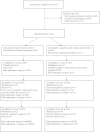No difference in 9-year outcome in CLBP patients randomized to lumbar fusion versus cognitive intervention and exercises
- PMID: 22669708
- PMCID: PMC3508245
- DOI: 10.1007/s00586-012-2382-0
No difference in 9-year outcome in CLBP patients randomized to lumbar fusion versus cognitive intervention and exercises
Abstract
Purpose: To compare the 9-year outcome in patients with chronic low back pain treated by instrumented lumbar fusion versus cognitive intervention and exercises.
Methods: The main outcome measure was the Oswestry Disability Index (ODI). Secondary outcome measures included pain, fear-avoidance beliefs, trunk muscle strength, medication, and return to work.
Results: One-third of the patients randomized to cognitive intervention and exercises had crossed over and been operated and one-third of the patients allocated to lumbar fusion had been re-operated. The intention-to-treat analysis detected no differences between the two groups. The mean adjusted treatment effect for ODI was 1.9 (95 % CI -7.8 to 11.6). Analysed according to the treatment received, more operated patients used pain medication and were out of work.
Conclusions: The outcome at 9 years was not different between instrumented lumbar fusion and cognitive intervention and exercises.
Figures
References
-
- Cowan JA, Jr, Dimick JB, Wainess R, et al. Changes in the utilization of spinal fusion in the United States. Neurosurgery. 2006;59:15–20. doi: 10.1227/01.NEU.0000219836.54861.CD. - DOI - PubMed
-
- Fritzell P, Hagg O, Wessberg P, et al. 2001 Volvo Award Winner in Clinical Studies: Lumbar fusion versus nonsurgical treatment for chronic low back pain: a multicenter randomized controlled trial from the Swedish Lumbar Spine Study Group. Spine. 2001;26:2521–2532. doi: 10.1097/00007632-200112010-00002. - DOI - PubMed
-
- Fairbank J, Frost H, Wilson-MacDonald J, et al. Randomised controlled trial to compare surgical stabilisation of the lumbar spine with an intensive rehabilitation programme for patients with chronic low back pain: the MRC Spine Stabilisation Trial. BMJ. 2005;330:1233–1239. doi: 10.1136/bmj.38441.620417.8F. - DOI - PMC - PubMed
-
- Brox JI, Reikeras O, Nygaard O, et al. Lumbar instrumented fusion compared with cognitive intervention and exercises in patients with chronic back pain after previous surgery for disc herniation: a prospective randomized controlled study. Pain. 2006;122:145–155. doi: 10.1016/j.pain.2006.01.027. - DOI - PubMed
Publication types
MeSH terms
LinkOut - more resources
Full Text Sources



